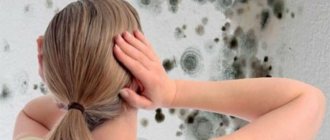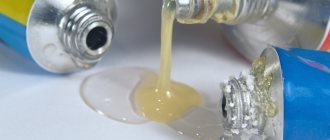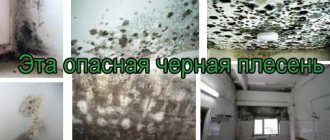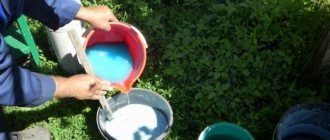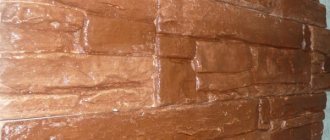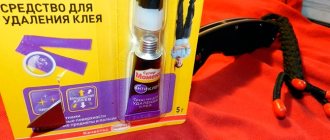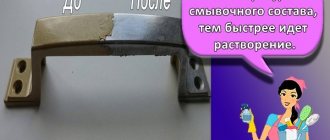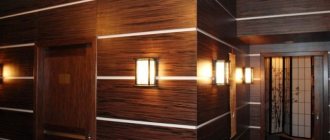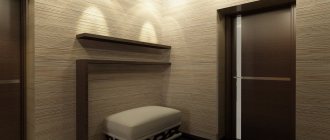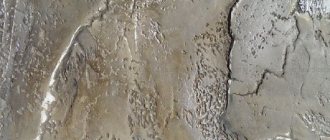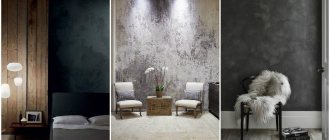How to treat walls against fungus
Often mold will spread through the plaster that needs to be treated.
But before that you need to check how well it sticks to the wall. This is done by tapping the walls with a hammer. If a dull sound is heard in response, this indicates that the layer of plaster needs to be completely replaced, since it has moved away from the wall. When the wall covering is reliable, it is simply treated with special antiseptics that kill the fungus. But here it is recommended to strictly follow the instructions specified in the instructions for the drug.
Work technology
- Wet the wall with water, which will prevent further mold from spreading along it. Using a special brush, remove the resulting fungus along with the layer of plaster. To improve the effect, you can clean the concrete with a substance that opens the pores of the cement.
- After the remaining plaster has been burned, the clean surface should be treated with an antiseptic. The wall is washed with a margin of 1 meter on all sides to kill all emerging pests. The solution can be applied with ordinary rollers, brushes or a spray.
- The next stage is priming the walls with a deep penetration agent that has a fungicidal effect. When the surface is completely dry, the primer must be applied again. Next, the walls are puttied, plastered and finished.
If the fungus has already abundantly filled the wall and penetrated deep into the plaster, then you should not place much hope on cosmetic treatment, because it will only relieve you of the problem for a short time.
Where does fungus usually appear?
You can identify several places in an apartment or house where mold occurs most often. These include the following areas:
- in wooden buildings it forms under the floor;
- in apartments, mold most often appears in corner rooms;
- in rooms with high levels of humidity, disputes arise very often, and such rooms include a bathroom or toilet;
- You can detect fungus in a room where the ventilation system is missing or not working properly.
Some people prefer to contact specialized companies to eliminate fungus because they are afraid that they themselves will not be able to cope with this problem. In fact, if you choose the right remedy for fungus on the walls, and also perform the procedure several times, you can easily eliminate all spores.
Before starting work, it is important to make sure that the room where mold was found will be constantly ventilated. Additionally, it is recommended to eliminate moisture and install a high-quality ventilation system.
Preliminary processing
Having determined what type of problem, we decide how to remove the parasites. But first we process the wall, if possible removing finishing and building materials already affected by spores.
- We put on protective clothing. Inhaling dust containing harmful spores, or even getting it on your skin, is very harmful to your health. You will have to use special overalls, gloves, masks and respirators.
- We tear off wallpaper or paintwork, knock down plaster, remove facing panels or tiles. If they are hit, they cannot be saved.
- We perform mechanical cleaning of the wall surfaces. It is best to use a metal brush or an attachment inserted into a drill for this, as well as a regular spatula. We clean as deeply as possible and expand as much as possible the boundaries of the area where the fungus treatment is carried out.
The Best Specialty Mold Removal Products
Table 1. Mold Removal Products
| Brand | Manufacturer | Volume, l | Average price, rub. |
| Dali | Russia | 0,6 | 170 |
| Alpa | Russia | 0,5; 2 | 540 |
| Tikkurila | Finland | 1 | 550 |
| Domestos | Great Britain | 0,5 | 230 |
| Pufas | Germany | 0,5 | 560 |
| Ceresit | Russia | 1 | 440 |
| Savo | Czech | 0,5 | 220 |
| Neomid | Russia | 1 | 350 |
The products are presented in minimal packaging, convenient for home use. Some of the products are marketed in containers of 5–20 liters.
DALI Universal antiseptic
The versatility of this aqueous solution is manifested in the possibility of use on all types of wall and ceiling surfaces. The active substance penetrates deep into the layers of the material, disinfecting and killing pathogenic spores.
Advantages:
- Efficiency.
- Low consumption.
- Ease of use.
- Safety.
Flaws:
- Acrid smell.
The composition is not diluted, but only mixed before use. The antiseptic is applied to the surface previously treated with a stiff brush. In case of large-scale damage, 2 layers of impregnation are required with drying between them for up to 6 hours.
Alpa Fongifluid (Fongifluid)
The product does an excellent job of antifungal treatment of wood; it also works on concrete, brick, plaster, plasterboard, and ceramics. An antiseptic is used against fungus to prevent and combat spores.
The product is sold ready for use, applied to the prepared surface
Advantages:
- Easy to use.
- Efficiency.
- Deep action.
Flaws:
- High price.
Manufacturers recommend leaving the anti-mold preparation on slopes and walls for 4–6 days, then cleaning and washing the treated area.
Tikkurila Homeenpoisto (Homeenpoisto)
A hypochlorite solution that removes mold from wooden, plastered, and concrete surfaces. Works well on painted and unpainted walls.
Advantages:
- Economical packaging.
- Neutral scent.
- Efficiency.
Flaws:
- Price.
The composition is applied using a sprayer or brush, first diluted with water in a ratio of 1:3. Depending on the degree of moldiness, leave for 30–90 minutes and wash off.
Domestos Spray Universal
Suitable for various surfaces, including those in contact with food, as well as for plumbing, cleaning mold from washing machines.
Advantages:
- Efficiency.
- Economical.
- Convenient format.
Flaws:
- The smell of bleach.
- Does not clean deep surface layers.
The substance is sprayed over the surface, left for a few minutes, and wiped off with a damp cloth.
Pufas Comet
Not suitable for wood, all types of wallpaper (paper, vinyl, non-woven), textiles.
A chlorine-based product that fights fungus on mineral surfaces
Advantages:
- Effectiveness.
- Ease of use.
- Fast results.
Flaws:
- Strong smell.
- Toxicity.
Strict adherence to safety measures is required. The product is sprayed on the walls at a distance of 10 cm, left to soak for 30–40 minutes, and rinsed off thoroughly.
Ceresit CT 99
It is an antibacterial fungicide against mold for concrete, stone, brick, plaster, but not for wood. For a long time, the composition protects the walls from re-infection.
Advantages:
- No pungent odor.
- Easy to use.
- Good preventive properties.
Flaws:
- Overcharge.
When working, be sure to use a protective mask and gloves. The primer composition is diluted according to the instructions and applied with brushes in a thick layer. The surface is cleaned and washed after 8–9 hours.
Savo Mold and Mildew Repellent
The spray is used on tiles, wood, plaster, paint, cleaning and disinfecting surfaces.
Advantages:
- Easy to spray.
- Whitening properties.
- Efficiency.
- Low prices.
Flaws:
- Not always freely available on the market.
- Pungent smell.
The product is sprayed over the entire pre-cleaned surface at a distance of 15 cm. It is washed off after 15–20 minutes, sometimes re-application is required.
Neomid Bio
A ready-made bioprotection solution on an environmental basis to prevent and eliminate traces of fungus on stone, plaster, ceramics, concrete, and brick.
It is optimal to use the composition before painting, pasting, or puttying walls for preventive purposes.
Advantages:
- Safety.
- Fast action.
- High efficiency.
Flaws:
- Unpleasant smell.
Chemicals that effectively eliminate mold spores include copper sulfate, the use of which against fungus involves preparing a special solution. 25–30 grams of powder must be dissolved in 1 liter of warm water and stirred thoroughly. The liquid is applied to the treated wall, the surface dries for 3–4 hours, the procedure is repeated 2–3 more times.
Popular anti-fungal products
These products have already gained popularity. They are used by both professionals and home craftsmen.
Prosept Anti-mold
The water-based product is designed to prevent and remove existing fungus.
The scope is quite wide:
- drywall;
- stone, including artificial;
- brickwork;
- concrete;
- Decoration Materials;
- wooden elements of buildings.
Prosept Anti-mold - independent coating and primer. Provided all recommendations are followed, the manufacturer guarantees protection of premises for 20 years or more.
Expert opinion
Borodina Galina Valerievna
In case of severe damage, wooden surfaces become very dark. Therefore, before applying a fungicidal primer, it is often recommended to treat with wood bleach.
Dufa Holzlasur
An alkyd-based product helps to repair and restore surfaces affected by fungus, as well as prevent the development of mycelium on new wood. The coating gives the material a glossy, silky feel. It is recommended that structures exposed to strong impacts be additionally coated with paint or varnish.
Fongifluid
Tikkurila's fungicidal solution fights a wide range of microorganisms. The drug is intended to prevent the development and eliminate existing fungus. The product is used on mineral and wooden surfaces, as well as on finishing materials - fiber cement, ceramic tiles.
Tytan FG-1
The product is designed for wood. The product is effective even on painted surfaces. Tytan FG-1 is used both inside and outside buildings. The composition is designed for bathrooms, laundries, kitchens, swimming pools.
One of the advantages of the product is that it can be applied even to uncleaned surfaces. Tytan FG-1 is applied in three layers, after which a decorative coating can be applied.
Wooden surfaces may slightly change color after treatment with primers. This must be taken into account when planning your interior design.
Mineral VGT
A water-based antiseptic protects most building materials, including stone, tiles, tiles, concrete, and bricks from fungus, mold, and algae. Duration of action - up to 12 years. The product is used both for prevention and for cleaning.
Pinotex Base
The primer is designed for processing wood, including sawn and planed wood. The product prevents the appearance of fungal diseases - rot, blue stains. Pinotex Base is not suitable for material already affected by fungus.
Abedis 06
The concentrate, in addition to mold, helps fight algae, mosses, lichens, and prevents the re-fouling of structural elements. Abedis 06 is combined with basic building and finishing materials, including tiles, terracotta, and ceramics. The drug does not stain the surface.
Dali
The primer easily penetrates into any material. It can be used on painted and varnished surfaces. The drug is effective against any biological lesions. The liquid is applied in any convenient way - using a roller, sprayer or brush. Small parts can simply be dipped in antiseptic.
Ceresit CT 99
Deep penetration emulsion intended for mineral surfaces inside and outside buildings. Wood processing is not provided.
The product has a deep penetrating effect, high vapor permeability, and does not leave marks on the surface.
Milkill
White latex based primer.
The drug prevents the entry and development of mold spores and destroys existing mycelium. Milkill is designed for finely porous materials with a low level of absorption, as well as for wood, plywood, polystyrene foam, cardboard and gypsum board.
The product is used to treat areas where leaks occur, walls and ceilings in wet areas - baths, swimming pools, garages, corner apartments, etc. The Milkill formula is effective and safe inside and outside buildings. The liquid may be applied using a sprayer.
How to remove fungus from the wall in a room without tearing off the wallpaper?
No one wants to get rid of the result of a renovation, so if mold appears, you shouldn’t rush to tear off the wallpaper.
If it has a green or dark green tint, this means that it has not had time to take root on the walls and can be removed without radical measures.
There are even folk remedies for this that are suitable for different types of wallpaper. There are three main types:
- Paper wallpaper is an inexpensive wallpaper that is easier to replace than to remove fungus from it, since stains will remain on it in any case.
This material is not intended for wet cleaning, so only dry cleaning products are suitable for it. - Acrylic - this type can easily tolerate wet cleaning, however, if mold appears on its surface, we can say with complete confidence that the fungus is on the walls themselves, since it simply appears on acrylic very rarely.
In this case, it is better to contact specialists and carry out major repairs, because even after cleaning, the mold will return. - Washable - this type is closer to paper wallpaper with the difference that any dirt, including mold, can be easily removed from it. To clean, you need to use wet products, and although it will take some time before the fungus is completely eliminated, it is possible to clean it.
Folk remedies for use at home
So, how can you remove mold from wallpaper in your apartment? The most famous folk remedies for mold removal are:
Baking soda - a special solution is made on its basis, in which one tablespoon of the product per glass of water, and then the resulting mixture is rubbed into the wallpaper with a soft sponge. Soda begins to work as an antiseptic, and not only removes dirt, but also creates a kind of film that prevents mold from appearing again on the affected area.
Vinegar - this product allows you to remove mold even from paper wallpaper. The vinegar solution should be poured into a spray bottle and treated with it on the affected area. Then, after about an hour, use a soft, dry sponge to remove excess product from the surface along with mold particles.
It is important to carry out this treatment several times in a row during the week in order for the effect to take hold.
Hydrogen peroxide - treatment with this product is similar to vinegar, only it acts more gently and not so quickly. It is well suited if, in addition to the mold itself, dark spots have formed on the wallpaper, since peroxide has a whitening effect
It is important to remember this before applying it to a colored surface, since it will definitely corrode some of the paint.
Ammonia is a very caustic and effective remedy, although it is better not to use it for wallpaper. Its solution with water in a 1:1 ratio copes well with fungus on tiles, wood or plaster.
Chemical substances
Due to the prevalence of the problem, household chemical companies have long begun to produce products to combat fungus on walls. They get rid of dirt faster, do not spoil the wallpaper, and the result of their action lasts quite a long time.
Their only drawback is a very caustic chemical formula, due to which the room with affected walls will have to be constantly ventilated so as not to suffocate from the smell of bleach.
The most effective mold control products on the Russian market are:
- Odorgone Professional for home is a chemical product made in the USA that helps fight the smell of mold and prevents it from spreading throughout the apartment.
The product has a local effect, and although it does not help get rid of the problem itself, it works great as an accompaniment to other chemicals for cleaning fungus.One bottle of Odorgone costs from 400 rubles, but since its consumption is very economical, it will be enough for a month of daily cleaning of the room.
- Cillit Bang. The product acts quickly, penetrates the wallpaper and can remove small growths of fungus on the wall itself. A single use is enough to completely get rid of dirt on the wall, and if you repeat the procedure regularly, you can completely get rid of the fungus itself. The product costs from 200 rubles per package of 750 ml.
- Sanitol Spectra - this product is used in cases where the affected area is too large, and the fungus itself has begun to spread not on the wallpaper, but on the walls.
Sanitol is needed just to clean the plaster from mold, and then re-glue the wallpaper onto the fresh surface. In Russia, it is difficult to find this product in the public domain, although it periodically appears in specialized building materials stores. The cost starts from 300 rubles per liter.
Review of the best premium-segment mold repellents
Kenaz "Anti-mold"
Quickly defeats pink and black mold, fights dirt and germs, and eliminates unpleasant odors. Prevents the appearance of repeated foci of fungus.
Kenaz "Anti-mold" in the ranking of the best remedies for mold on walls for 2021
Contains active chlorine and alkalis. Suitable for different materials, but changes the color of painted surfaces. Available in 0.8 liter volumes in a convenient bottle. The product itself has almost no smell and is comfortable to work with. All you need is gloves.
Pros:
- active against various types of fungus;
- economical consumption;
- combating unpleasant odors;
- long-term protection;
- thoughtful packaging.
Minuses:
- not described.
Glutoclean spray
The standard of German quality. An effective remedy for combating mold. Available in a volume of 750 ml in the form of a spray, the spray force is adjustable from a stream to a fine suspension.
Glutoclean spray in the ranking of the best remedies for mold on walls for 2021
The effect is achieved by the presence of active chlorine and acids in the composition. Eliminates dirt and unpleasant odors. The exposure time before rinsing is 15 minutes.
Pros:
- comfortable use;
- fast action;
- prolonged effect.
Minuses:
- It is not always easy to find on sale, only in online stores.
Concentrate Pro-Brite Septa 100
Concentrate based on benzalkonium chloride and surfactants. Sold in a 5 liter canister. It is used sparingly, since it is a concentrated product, and therefore it will last for a very long time.
Pro-Brite Septa 100 Concentrate ranks as the best wall mold repellent for 2021
Copes with various stains, even the most stubborn ones. Kills microbes, thereby preventing the formation of fungus. Conquers unpleasant odors. Requires dilution in water, you need to work with gloves.
Pros:
- effectiveness;
- quick effect;
- large volume;
- prolonged prevention.
Minuses:
- only for plumbing.
Mold removal methods
In a private home: Eliminate possible preconditions for the appearance of fungus:
- Frequent ventilation, open curtains during the day.
- Ventilation of toilets and bathrooms - install fans; after taking a shower and when drying clothes, do not close the doors to the bathroom (excess moisture contributes to the formation of mold).
- Normal air circulation in the rooms - leave a small distance between the furniture and the wall, remove debris from corners and mezzanines.
To destroy emerging fungus, use a solution of soda and table vinegar. After the chemical reaction, remove the residue with a brush or spatula. If mold has deeply affected the wall, partially remove the putty and warm the area with a hair dryer. Then treat with a solution of copper sulfate, or a special anti-mold compound.
Interesting fact: In 1771, a plague epidemic began in Moscow. Grigory Orlov, Catherine’s favorite, gave instructions to ring the alarm bells, as had long been the custom during times of troubles and misfortunes. And, as if by a miracle, the epidemic began to decline. However, recent studies have shown that bells simply have a frequency spectrum of sound that inhibits the growth of pathogenic microbes and mold, and at the same time increases human immunity.
How to eliminate fungus on the walls and ceiling in the bathroom
Bathrooms and toilets are prime breeding grounds for mold. If a problem appears on the tile, we immediately check the ventilation; if there are no problems, we can get by with an additional fan.
- We clean the tiles, dry them and treat them with vinegar (copper sulfate, bleach, hydrogen peroxide). Afterwards we treat it with a solution of soda (4 tablespoons of soda per 1 liter of water).
- If the tile seams are hit, we try to solve the problem using a solution of soda and an old toothbrush. If after complete drying it was not possible to lime the “occupier”, you will have some minor repairs. We open the seams and remove the grout, treat it with a product, wait for it to dry and seal it again.
- You will have to tinker with problems on the ceiling. We clean the whitewash from the ceiling by moistening the surface in advance (there will be less dust). Treat with a primer containing an antiseptic and dry. And we do finishing work.
The most inexpensive means for removing and preventing mold
"Abedis 06"
A Polish product with a high level of safety, Abedis 06, is universal and can be used in children’s premises. The main component of the product is guanidine, a strong antiseptic substance. The preparation is suitable for interior and exterior treatment of buildings, as well as small buildings such as a gazebo or greenhouse. Also, using this emulsion you can disinfect garden paths. "Abedis 06" can be used for prevention (the drug can be added to paints and mortars) and to remove fungal plaque.
Before work, the emulsion should be diluted with water in a ratio of 1:2, then treat the contaminated surfaces with the resulting solution. The mixture is left for a day until completely dry, after which it is removed with water. When the treated surface is completely dry, it is recommended to repeat the procedure, but not earlier than after 3 days. Despite the harmless composition, you must use protective equipment when working.
The average cost is 177 rubles.
Advantages:
- suitable for children's premises;
- the composition does not contain harmful components;
- budget drug;
- excellent result.
Flaws:
- not found.
"Neomid Bio Repair"
An environmentally friendly disinfectant made in Russia. Thanks to its formula containing substances harmless to humans, as well as a reasonable price-quality ratio, it has gained particular popularity. Available in the form of a ready-made solution for treating small rooms, apartments, or a concentrate for cleaning large areas of infection. In addition, Neomid Bio Repair is used during the construction phase as a prophylactic agent to prevent the occurrence of mold.
The drug is sprayed onto the infected area and then left for two hours. After this, remove it using a scraper. The procedure can be repeated if necessary. If the treatment takes place outdoors, it is not recommended to get moisture on the cleaned surface - the humidity should be no higher than 60%, and the temperature should be from 15 to 20 degrees Celsius. If processing is carried out indoors, good ventilation should be ensured. The duration of the effect, according to the manufacturer, reaches 20 years.
The average cost is 289 rubles.
Advantages:
- convenient release forms
- price-quality ratio;
- ease of use;
- safe components in the composition;
- does not affect the original color of materials;
- long lasting effect.
Flaws:
- strong chemical smell.
"Biotol-spray"
A powerful Russian antibacterial agent for treating surfaces made of natural stone, wood, concrete and other common materials. The drug does not contain heavy metals, mercury and chlorine. Has a slight chemical odor. "Biotol-spray" demonstrates a wide range of applications - treatment of basement floors, building facades, attics, roofs, balconies, as well as disinfection of architectural monuments, memorial fences, slabs and restoration work.
If the infection is severe, the surface must first be cleaned of mold mechanically using a scraper or brush, carefully removing the layer of contamination, being careful not to spread the fungus to adjacent clean areas.
It is recommended to spray the spray onto the treated area from a distance of 30 cm, then leave the solution for a day or two, after which you can remove the drug along with the fungus and clean the surface with a brush. The solution can be reapplied if the infection is old or advanced.
The average price is 300 rubles.
Advantages:
- strong drug;
- suitable for most materials;
- without harmful impurities;
- faint smell.
Flaws:
- not detected.
"Belinka"
A widely used drug produced in Slovenia. “Belinka” does not contain a bleaching agent and does not affect the color of the surface being treated, which is why it is used for treating colored surfaces. The substance quickly and successfully eliminates numerous types of fungus, both in dry rooms and in places of high humidity. Suitable for treating concrete and plaster surfaces and used for disinfecting ceilings, walls, floors, attics and basements.
To get started, you need to prepare a solution in a ratio of 1:4, which is applied to the affected surface using a brush or spray. It is recommended to work at temperatures above 5 degrees Celsius and a humidity level not exceeding 80%. After the solution has completely dried, you can remove dirt; it is advisable to do this using hot water and under pressure. It is better to clean large areas affected by fungus again. After drying, you need to apply a primer and then a topcoat.
The average cost is 350 rubles.
Advantages:
- does not distort the color of the material;
- for dry and wet rooms;
- wide range of applications;
- affordable price.
Flaws:
- not found.
Basic means for combating mold on walls
Before getting rid of mold on the walls, it is necessary to carry out a set of preparatory work. First of all, you need to be properly equipped. The presence of rubber gloves, a hat and clothing that protects the body is an indispensable condition.
As for the room itself, the affected surfaces must be pre-treated. To do this you need:
thoroughly dry the room, paying special attention to the corners; remove old wallpaper, wall panels, drywall or other facing materials, as is usually done before renovation; ensure high-quality constant ventilation; treat the affected surface with warm soapy water and walk over it with a stiff brush or spatula.
After that, you can apply a mold repellent to the wall and let the surface dry. Let's look at various means of combating black spots of fungus on walls and how to use them in more detail:
- Bleach. You can purchase a special product at the hardware store, or you can make your own bleach at home by adding a glass of bleach to a liter of water. The solution is applied very simply, using a regular washcloth or sponge. Not the most effective remedy, since it can destroy only about 80% of the spores. In addition, an aggressive environment can ruin carpet, laminate or any other floor covering. And some toxic compounds can even harm the health of people living in the premises;
- Vinegar. Being a weak acid in its composition, ordinary table vinegar is a very effective means of combating fungus. It is non-toxic and can destroy up to 99% of bacteria and up to 80% of viruses. It is enough to pour a five percent solution into any spray bottle and apply it to the affected area. And in order to get rid of the pungent odor, you can add a few drops of essential oil. The treated surface is left for an hour, after which it is thoroughly washed with water or soap solution;
- Baking soda. An excellent antiseptic, environmentally friendly, safe and soft. Soda has high cleaning properties, while being quite gentle on the surface. It is known that the most difficult place to get rid of mold is in the bathroom or toilet. With the help of soda, this problem is much easier to deal with. Due to the softness of soda, the risk of damage to the surface of walls or floors is almost completely eliminated. Experts recommend not rinsing soda off the surface to be treated for as long as possible, as it prevents mold from reappearing;
- Hydrogen peroxide. A regular 3% solution is poured into a spray bottle, which is used to treat the affected surface. After 10 minutes, the remaining composition can be washed off. Unlike chemically aggressive bleach, hydrogen peroxide is safer, both for various surfaces and for human health;
- Copper sulfate. A very effective and affordable product that can be purchased at any pharmacy. It is enough to dissolve 500 grams of copper sulfate powder in 10 liters of water - and the working solution is ready! For greater effect, you can add 500 grams of sodium fluoride. The solution is applied to the surface using a spray bottle, sponge or washcloth. After about 30 minutes, the treated area should be treated with a warm soapy solution;
- Borax. A special product that can be purchased at the hardware department. Very good for fighting mold and mildew. Approximately 450-500 grams of borax are diluted in 5 liters of water. To enhance the effect, you can add 200 grams of boric acid or 700 ml of vinegar. This solution is absolutely non-toxic, harmless to health and surfaces and allows you to very effectively remove black mold deposits not only from the walls, but also from the ceiling;
- Special factory-produced products. Today, in any household chemical store you can purchase products designed to combat mold and mildew. They are quite effective and easy to use, and also have detailed instructions for use. But their disadvantages include the presence of aggressive chemical components and relatively high cost.
Types of mold repellents
To combat mold, it is important not only the quality of surfaces, but also the choice of a suitable product. It is necessary to carry out careful processing so that the composition penetrates into all pores, cracks and hard-to-reach areas.
There are different types of mold repellents:
- aerosols;
- primers;
- fungicidal impregnations for wood;
- solutions with active ingredients.
Let's take a closer look at them.
Aerosols
Aerosols are applied during cleaning for prevention, as well as on surfaces affected by mold. Application to finished and unfinished walls is allowed, but for an even coating the surface should not be embossed.
The spray intensity is adjustable from jet to spray. It is better to spray the product while holding it in your hand at a distance of 20 cm from the wall. You need to work in closed clothing and a respirator to protect your skin and respiratory organs. And after treatment, you must leave the room for at least half an hour.
Special solutions
The active ingredients are antiseptic additives. Solutions are used when there is a lot of mold. Then you have to use a rag or sponge. This cleaning can be carried out after repairs as a preventative measure. Processing must be done according to the instructions. Sometimes once is enough, and sometimes you need to repeat. You need to wear gloves when working, but it is not necessary to wear a respirator.
Prophylactic solutions are combined with soap and water in the specified proportions. Concentrated solutions are also diluted before use. The main thing is to accurately calculate the amount of solution; leftovers cannot be stored.
There are compositions aimed at combating mold of one or several types. The latter are called antiseptics with a wide range of applications. Such products are often able to defeat the fungus in one application.
Primer
Priming walls and ceilings is an important stage of repair. Due to active fungicides and the ability to penetrate deeply, the primer fills cracks, crevices and pores in the surface, therefore it fights existing spores and also prevents their development and the formation of mold. Typically the composition is capable of penetrating to a depth of 5 to 15 mm.
Impregnations for wood
These are specialized compositions for treating wood products containing fungicidal additives. In addition to fighting mold, they disinfect and prevent the destruction of wood. A significant plus is that the impregnation lasts for 5 years, all the time protecting the tree from fungal spores.
Copper sulfate for mold and mildew
How to prepare the surface for processing
Before treating the walls with copper sulfate, you should prepare them. But first of all, remove everything unnecessary from the room: furniture, linen, household appliances and more.
Carefully inspect everything removed for the presence of mold. She can hide on the legs of the bed and sofa, on the back wall of the closet and its bottom. Things need to be disinfected. Otherwise, they may be a new source that will re-infect walls and other surfaces. And you will have to carry out all the processing and disinfection manipulations again. To prepare the walls, do the following:
- First you need to find the main source of mold. It can be in the most difficult to reach places, for example, under tiles. You need to tap the tiles; if there is a void underneath, it is likely that there is fungus there. In such areas it is better to remove the tiles. Mold can also hide under the wallpaper. They will have to be removed too.
- After mold is found and the walls are cleared of tiles, wallpaper and other coverings, begin cleaning. Take a metal spatula or stiff brush and remove all plaque. Then go over again with low-grit sandpaper.
- Next, wipe all the walls with soapy water and wait until they are completely dry. This will make treatment with copper sulfate more effective.
How to dilute copper sulfate to treat walls against mold
Copper sulfate is available in dry form, so it is diluted in water. You need to take 100 grams of blue powder and pour it into a metal container with 10 liters of water. The water should be warm. Mix the granules well in the water until they are completely dissolved.
How to treat walls against mold with copper sulfate
Pour diluted copper sulfate for wall treatment into a spray gun or spray bottle. Apply thickly to all affected areas. If you don't have a spray bottle, use a regular kitchen sponge. After 3–5 hours, copper sulfate should be sprayed again against mold in all treated areas.
This treatment is carried out 2 to 5 times. It all depends on the depth of mold damage to the walls. In the most advanced cases, it is necessary to remove a layer of plaster before treatment.
The product will dry completely only after 2-3 days. Limit your time in the contaminated room to a minimum.
Safety precautions when using copper sulfate
- Wear thick rubber gloves, a respirator or cotton-gauze bandage, safety glasses and special clothing. Tight, closed clothing with long sleeves is suitable.
- After disinfecting surfaces and walls, ventilate the room well.
- Clothes used for treatment should be washed separately from other laundry and dried in fresh air.
- If you experience slight malaise, dizziness, headache, nausea or allergic rashes, consult a doctor immediately. These may be signs of poisoning.
Folk remedies
Just a few decades ago in Russia there were almost no remedies for fungus. Therefore, we used available drugs. They still exist in every home.
Expert opinion
Borodina Galina Valerievna
Even when working with homemade preparations, safety requirements should be observed. Work must be carried out wearing gloves, a respirator and safety glasses to protect the skin and mucous membranes, and respiratory organs from chemical burns.
Copper sulfate
Copper sulfate is one of the most effective products in the fight against fungus. It is used in the form of a solution prepared from 20–30 g of powder (granules) and 1 liter of warm water. To enhance the effect, add 1 tbsp. l vinegar.
The processing is carried out as follows:
- Clean areas with traces of fungus using a spatula or sandpaper.
- Wipe the wall with soapy water and leave to dry.
- Apply the vitriol solution using a sprayer or sponge.
- After 3 hours, repeat the treatment. Impregnation is performed up to 5 times.
Sodium hypochlorite
"Whiteness" is a cheap bleaching agent that is found in almost every home. It turned out that sodium hypochlorite, the active component of the chemical drug, is effective against fungus. The liquid is used to treat all types of building materials, including wood. If mold appears on the walls, wipe the affected areas with bleach. But the size of the fires should not exceed 2 m2.
However, it must be taken into account that sodium hypochlorite will not provide long-term protection against fungus; the action will last for 2-3 months. To slightly extend this period, you can add boric acid (1–2%) to the product.
Another disadvantage of bleach is its surface action. In addition, chlorine is aggressive towards most finishing materials. Therefore, before use, you should check compatibility on an inconspicuous area of the wall (ceiling).
Whiteness is not used in its pure form. It is first diluted with water.
Concentration of bleach for processing different materials:
| Material name | Solution composition (bleach:water) |
| Wood | 1:2 |
| Concrete | 1:1 |
| Tile joints, ceramic tiles | 1:1 |
| Brick | 1:1 |
| Joints between tiles | Pure bleach |
Fallen trees, which are often used for construction in the private sector, are most often contaminated with fungal spores. At first the logs appear clean. But then, even with proper use, the surface may darken. Therefore, experts recommend treating a wooden house inside and outside with sodium hypochlorite.
In everyday life, “Belizna” is also used in combination with soda ash. To do this, 5–7 tablespoons of sodium carbonate powder are diluted with such an amount of bleach to obtain a mass of sour cream thickness. The mixture is applied to the facing seams, left for 20–30 minutes and washed off with water.
Borax
Sodium tetraborate, a popular and affordable disinfectant, also exhibits fungicidal properties. To clean mold from your home, prepare a working solution: 1 cup of borax powder is diluted in 2.5 liters of water. The liquid is applied to the walls with a stiff brush, while cleaning the surface.
Vinegar
Vinegar helps combat mold fungus. The product is sprayed generously onto the darkened surface and wiped with a clean rag. At the end, the drug is washed off with clean water.
A solution of peroxide, vinegar and boric acid
For an antifungal agent, the components are taken in the following proportions:
- hydrogen peroxide - 2 parts;
- vinegar - 2 parts;
- boric acid - 1 part;
- water - 4 parts.
The blackened areas are treated with the mixture from a spray bottle, then the walls are washed with water.
Home remedies are usually less effective. Therefore, they are resorted to only in the initial stages, as well as in cases where there is no opportunity to purchase industrial drugs.
Using copper sulfate
One of the most effective ways to remove fungus from floors, ceilings and walls is to treat them with copper sulfate. To do this you need:
- prepare the solution correctly;
- treat disinfected surfaces;
- take care to comply with safety regulations.
Compliance with these points will help to effectively deal with fungal spores and prevent its reappearance.
Preparation of the solution
Not everyone knows how to properly dilute a solution of copper sulfate so that the liquid is effective, but not toxic to the person himself. You will need:
- 2 liters of water;
- 50 grams of copper sulfate;
- 2 tablespoons vinegar.
Vinegar is not a required ingredient, but its use will increase the effectiveness of the medicine.
Proper wall treatment
It is not enough to simply prepare a solution and spray it on the damaged areas. The effect of the drug will be greatly weakened, and we will not get the desired result. It is necessary to prepare the room by following these steps:
- clean the walls of wallpaper, whitewash or paint;
- remove excess plaster;
- clean the surface to be treated with sandpaper;
- wash the walls with soapy water;
- dry the room.
Only after completing all these steps is it possible to begin processing with copper sulfate.
Cleaning paint, wallpaper and whitewash
Fungal spores penetrate deeply into the structure of the affected material, and surface treatment is not a panacea in the fight against it. Wallpaper, paint and whitewash are weak barriers to mold.
Scraping plaster
The plaster, if an infection has formed on it, will also have to be removed. This is necessary in order to remove the roots of the problem, and not to deal with its superficial consequences.
Additional sanding
Sandpaper will remove excess damaged materials remaining in cracks and pores. This will allow you to get rid of potential sources of re-occurrence of infection.
Note! During the entire cycle of preparatory and disinfection measures, ensure the availability of personal protective equipment. First of all, this concerns the respiratory tract and eyes.
Washing walls with soapy water and drying
Washing the walls is considered the final preparation step, with the help of which the most microscopic chances of mold reappearance are removed. Naturally, if the main sources of fungus are not eliminated, it will make itself felt again after a while. Keep this in mind and do not expect that treating the walls will eliminate the need to solve other problems related to the prevention of new mold outbreaks.
Treatment with vitriol
The process of treating a room with copper sulfate is extremely simple and consists of only two steps:
- direct treatment of contaminated areas;
- air the room for 2-3 days.
Precautionary measures
Before treating a room with copper sulfate, be sure to take the following precautions:
- Open windows and doors indoors to allow air to circulate. If there are no windows, turn on the hood.
- Wear personal protective equipment. The minimum set consists of rubber gloves, safety glasses and a respirator. It is ideal if the skin and head are also protected with special clothing.
Side effects
Side effects that occur with vitriol poisoning:
- stomach ache;
- cardiopalmus;
- skin rash;
- itching;
- nausea;
- weakness.
If these symptoms occur, you must immediately stop the treatment process and leave the room.
We use lime
When choosing plaster for wall finishing, experts advise purchasing lime-based mixtures. Their advantages over cement analogues are as follows:
- The composition has antiseptic properties that prevent the occurrence of harmful organisms.
- They have greater permeability, allowing moisture to evaporate faster from the surface.
- Helps maintain optimal humidity levels in the room.
Microwave method
The essence of the method is to heat mold-affected areas of the wall to a temperature of 70 o, to a depth of 35 centimeters. This is enough for excess moisture to evaporate and the mold to die. Advantages of the method:
- non-toxic;
- high speed of getting rid of fungus;
- versatility in use. Suitable for processing a wide range of materials;
- allows you to destroy harmful organisms in hard-to-reach places.
Review of the best budget mold remedies
"CHISTIN" Sanitary and hygienic gel 3 in 1
Antiseptic concentrated gel based on chlorine and alkali. Differs in versatility. Good for cleaning walls, floors, tiles, plumbing fixtures, removing stubborn dirt and cleaning drains. Effective against mold, limescale and rust. Copes with unpleasant odor.
"CHISTIN" Sanitary and hygienic gel 3 in 1 in the ranking of the best remedies for mold on walls for 2021
The exposure time depends on the area of application and is described in the instructions. So, for simple cleaning, 5 minutes is enough, for stubborn dirt - about an hour, and to clear blockages you need to leave the gel on overnight. It is necessary to work with gloves. Not suitable for acrylic and stainless steel. The bottle contains 750 g of product and includes a measuring cap.
Pros:
- acts quickly and effectively;
- acceptable price;
- versatility;
- good antiseptic.
Minuses:
- smells strong.
"Floreal" "Rapin Mold"
A universal effective remedy that fights moss, mold and other fungi. Its beauty is that it is suitable for ceramics and concrete, stone and wood, plastic, plaster and even textiles. Copes with cleaning stubborn dirt, cleans tile joints, and resists corrosion.
"Floreal" "Rapin Mold" in the ranking of the best remedies for mold on walls for 2021
The main components are ammonium compounds. Packaged in 550 ml bottles with a convenient sprayer. Spray intensity is adjustable. The product can also be used in families with children. You must work with gloves.
Pros:
- soft composition;
- ease of use;
- acceptable price;
- forms a protective layer.
Minuses:
- not described.
Luscan Economy
A product based on hydrochloric and oxalic acids, as well as surfactants. Thanks to this composition, it is characterized by versatility in use. Fights mold, lime deposits, rust and unpleasant odors. Available in gel form. Easy to apply without bleeding. Fights germs.
Luscan Economy in the ranking of the best products for mold on walls for 2021
Gloves are required for work. Not suitable for acrylic bathtubs and bathtubs with restored enamel. One bottle contains 750 ml of gel. Due to the fact that it is consumed economically, it lasts for a long time.
Pros:
- active ingredients;
- antimicrobial protection;
- convenient application;
- versatility;
- pleasant aroma.
Minuses:
- not detected.
Gel "SANELIT Oxygen"
This active cleaning gel has earned a good reputation among customers. The product is based on citric acid, surfactants and oxygen-containing additives.
Gel "SANELIT Oxygen" in the ranking of the best remedies for mold on walls for 2021
Thanks to this, it is a universal remedy, and not only fights mold. A significant plus is gentle cleaning, so the gel is suitable even for enamel, acrylic and plastic, stainless steel products and chrome parts. The bottle contains 0.5 liters of gel.
Pros:
- smells good;
- universal;
- gentle on surfaces;
- budget;
- fights mold, lime and rust;
- cleans quickly.
Minuses:
- not described.
Causes of mold
The analysis should begin with the reasons why mold appears in homes in the first place. If they are quickly eliminated, then no treatment may be required at all.
This is what mold looks like under a microscope
Mold is a fungus. There are several types of it. It reproduces through spores that constantly fly in the air. These spores are literally everywhere, we breathe them all the time. In fact, these spores are in an inactive state and begin to develop into full-fledged mold only under certain conditions.
All types of mold fungi can be divided into harmful and beneficial. The latter are used in the food industry (cheese, yeast, wine, citric acid and others) and medicine (antibiotics), but no one wants to use harmful ones, but it is impossible to get rid of them, since these organisms survive even in vacuum conditions in space.
The walls are affected by black mold
The main factor influencing the proliferation of mold fungi is high humidity (60% and above). The humidity level in a room can increase for the following reasons:
- The ventilation system is clogged or improperly designed - there is nowhere for steam to escape. This is especially true for bathrooms.
- The technology for constructing the walls has been disrupted, as a result of which they no longer allow steam to pass through.
Very important! This problem often happens in houses built from lightweight concrete blocks, such as foam blocks. These materials are highly hygroscopic, so they literally draw moisture from the air.
In order for it to successfully leave the thickness of the walls, it is necessary to provide ventilation gaps under the façade finishing, which is often forgotten to be done, or they do not know anything about it at all. There is a ventilation gap under the facing brick
- Vapor-tight interior decoration, coupled with poor ventilation, can also cause moisture accumulation in the room. Steam does not pass through walls.
- Water and heating pipes, underfloor heating systems and plumbing fixtures may also leak. The constant flow of water does not allow surfaces to dry out.
- Incorrect insulation. As a result, the dew point may be inside the wall or even inside the room, causing condensation to form. It also appears on pipes with cold water, especially during the heating season.
- The walls of the building may freeze. This happens especially often in the corners of rooms, as shown in the photo above. In this situation, only external insulation will save you. The fungus can be killed with an antiseptic, but without thermal insulation it will still return after a while.
This corner freezes during cold weather
There are other reasons, but the main ones have already been announced.
Where does mold like to live?
Mold actively reproduces on mineral substrates, especially on gypsum (you can learn more about the causes of mold on drywall from the article on our website). This material is of organic origin, which means that fungi receive nutrients from it for their vital functions. This is also unpleasant because such bases are porous and rough. Mold settles deep inside them and it becomes very difficult to remove.
Gypsum grout is literally saturated with mold
It multiplies worse on concrete, but this can happen at high humidity. And if you consider that all concrete foundations in the house are finished with gypsum putty or paper, then there will always be enough space for development.
Tile tiles are affected by fungus only in very advanced cases. It will not be difficult to remove plaque from it. It is much more difficult to remove it from seams rubbed with plaster mixture.
Advice! When grouting tiles, buy more expensive hydrophobic mixtures, as they can resist the appearance of microflora longer. Also treat them after drying with antiseptic agents such as “Dolphin”. Bathroom antiseptic against mold for treating tile joints
Wallpaper, especially paper, suffers the most from mold. You can’t just remove it - after treatment, repeated repairs are almost always required. (When re-repairing, you need to properly remove wallpaper from drywall - read about this on our website).
Mold can also actively grow on water-based paints.
In rooms with high humidity levels, we try to use less plaster and wallpaper for finishing.
TOP 5 remedies for fungus in the apartment
The appearance of fungus on the walls is an extremely unpleasant phenomenon that can negate costly renovations in the apartment.
Mold not only spoils the appearance, it worsens the indoor microclimate and harms human health. Timely identification of the “enemy” greatly facilitates the fight against the fungus. Details about methods of combating dangerous biological phenomena are described in one of the articles on our website.
Mold spores are toxic. Once in the human body, they can cause a number of diseases: allergies, bronchitis, migraines, tuberculosis and asthma. Elderly people and children are especially susceptible
The following signs indicate the appearance of fungus in the house:
- the presence of gray, black, dark green dots and spots on the walls or ceiling;
- the appearance of a damp, unpleasant odor in the room;
- peeling paint, wallpaper, crumbling plaster and darkening of tile joints.
Some may notice a deterioration in their health - concentration decreases, headaches become more frequent, and fatigue occurs.
Mold must be removed in a comprehensive manner. Final and irrevocable disposal of the fungus can be achieved by eliminating the causes of its appearance.
The main reasons for the formation of fungus are: air humidity above 70%! and temperature conditions from 20°C. "Crying" windows - the first alarm signal
However, humidity and temperature are far from the only factors in the development of harmful microorganisms.
Significant reasons include:
- Lack or insufficient ventilation. As a rule, the fungus begins to develop in the corners of the room - in the place where air stagnation occurs. With sufficient “blowing”, turbulences are formed - the air blows out the spores, and excess moisture is discharged into the ventilation duct.
- Poor quality waterproofing of the foundation. As a result of poor-quality construction, capillary leakage of moisture from the damp foundation occurs - the walls in the house become damp.
- Unsatisfactory condition of the water supply and sewerage leaks. Periodic wetting of the floor, ceiling, walls and utility channels creates a favorable environment for the development of fungus.
- Thin freezing walls. Due to poor thermal insulation, the dew point shifts, and condensation settles on the walls from inside the room.
- Cold attic or leaking roof. This is a common cause of mold on upper floors and attics.
- Improper use of a humidifier. When creating tropical conditions for exotic plants, mold sometimes settles in greenhouses.
Most finishing and building materials can be affected by fungus. Dark spots appear on wallpaper, tiles, wood trim and plaster.
Image gallery
Photo from
The most favorable conditions for the appearance and spread of fungus are bathrooms, showers and toilets, i.e. rooms with high humidity levels
Mold always accompanies violations of building regulations. If a plastic baseboard is laid without a ventilation gap, fungus will certainly grow under it
With incredible speed, mold spreads in the seams between the elements of the tile cladding. Therefore, for arranging bathrooms, it is recommended to use tile adhesive with an antiseptic
Fungus on window slopes is often caused by non-compliance with installation techniques: insufficient waterproofing of the slopes or a leaky installation seam. Inadequate wall insulation can also lead to mold growth.
If the room is not equipped with ventilation that provides adequate air exchange, mold can appear even under paper wallpaper
Mold almost always appears under “non-breathable” finishes that do not allow air to pass through, especially if the application technology is violated
Mold can attack almost all building materials from which load-bearing structures are constructed. It destroys concrete, brick, wood
In order to prevent destruction and prevent the appearance of mold, means are used to get rid of the fungus and carry out prevention
Mold in the bathroom
Mold area under plastic baseboard
Mold growth in tile joints
Fungal colonies on window slopes
Mold on concrete under paper wallpaper
Fungus colonies under vinyl wallpaper
Blue mold on wood
Means of combating destructive phenomena
In addition, mold fungus can settle in household appliances; washing machines, dishwashers and microwave ovens are most often affected by its appearance.
The ideal option to fight fungus forever is, of course, a major overhaul of the ventilation duct or at least its inspection by professionals to ensure normal access to air flow. Thanks to this, the room will be properly ventilated and will not start. You should also take care of normal heating or insulation of the room.
If you don’t have time for repairs, or everything is in order in your home with heating or ventilation, then the most effective way is to use antiseptic drugs. The use of special anti-fungal products that help get rid of them, if not forever, then at least for a longer period than simply wiping with a rag with vinegar or hydrogen peroxide.
- The drug is intended primarily for bathrooms, basements, cellars, greenhouses and apartments, as well as any other most damp rooms.
- Price – 100 rub. (1 l), 360 rub. (5 l).
- Does not contain chlorine compounds or volatile toxic substances.
- Colorless and safe for people and animals.
- Can be used on concrete, brick, painted and plastered walls, wood, ceramic, stone, plasterboard and other surfaces.
- Sold in construction supermarkets
We suggest that you familiarize yourself with a preparation against mold on walls
Review: Olga, Tver
Removing with Olympus is a pleasure. Of course, you need to protect yourself properly, cover your hands with gloves or long sleeves, protect your eyes and respiratory organs. But after a couple of days you will forget that you ever had this nasty thing in your bathroom. It removes well, so it gets right into all the pores; it wasn’t even in the space between the tiles in the bathroom. I noticed this because the tiles on our wall are small. Everything is clean and permanent. It's been 8 months now and still no mold.
Neomid Bio
- Issue – Russia.
- The form of release of the product is a concentrate in the form of a spray.
- The volume of the bottle with a dispenser spray is 0.5 kg.
- The active substance is a set of antifungal and antibacterial biocides, plus water.
- How to use - apply to an untouched moldy surface and remove after an hour or two by scraping with a spatula from the wall or wallpaper.
- It is allowed to store no more than 2 years.
- Approximate cost – 470 rubles. , available for free sale
Review: Alexander, Voronezh
I decided to just buy a cheaper anti-fungal remedy in the toilet room. I came across Neomid Bio, tried it, and it seemed to work. The fungus has disappeared, 5 months have passed, the spots have not yet appeared. Of course, I had to apply it with a brush twice, because this mold did not go away for a long time. I fiddled with it for about 5-6 days. Then I noticed that it was not there, I washed the wall in the toilet and dried it. It seems like a good remedy, but probably something more expensive would have dealt with the fungus faster, I think so.
- Manufacturer of fungicidal solution – , Russia.
- Price – 550 rub. (2 l), 1150 rub. (5 l), 3250 rub. (20 l).
- The liquid formula is based on antifungal and anti-mold components.
- Designed for application to the interior surface of a house or apartment, as well as for treatment outside the house.
- Does not harm the color and shine of tiles, paints and other surfaces.
- Already in a ready-diluted state, therefore its consumption for efficiency is recommended by the manufacturer - 1 l / 4-5 sq. m.
- You can buy it in the online store
Before use, all loose, rough and porous surfaces must be sanded, smoothed and leveled. This is the only way the product will penetrate well into all the cracks and dimples. In case of severe damage to certain areas with mold, repeat the procedure 1-2 more times. Do not apply the product in a cold room at temperatures below 5˚C. Use a roller, brush or special gun to apply, then simply wash the tools with water.
Review: Marina, St. Petersburg
Thanks to this mold remover, I was able to help my grandmother clean the bathroom in her old apartment. Moreover, it was important for us not to call any specialists, so as not to pay three times. It was enough to buy a liter bottle for 220 rubles, which helped to promptly clean the corner near the bathtub from mold. Of course, ideally, you need to change the siphon or somehow ventilate the space under the bathtub, but then you will have to call repairmen, because the bathtub is hermetically sealed. So far we've made do with the Fongifluid Alpa. Thanks for that too.
- This product copes well with fungi, so much so that even its repeated use allows these formations to go away forever.
- Manufacturer – Germany. Price – 840 rub. (10 l).
- The product should be used in the following proportions – 70-100ml/sq.m.
- The drug can be used both for indoor and outdoor work, where fungus needs to be removed. It is enough to dilute in a ratio of 1:3 and you will have a suitable concentrate for combating different types of fungi.
- The liquid has a pleasant aroma due to the flavoring agents it contains, in addition to the included main components - heterocyclic biologically active fungicidal and antifungal substances.
- You can buy it here
Reviews: Natalia, Pskov
After we tried to remove the fungus in the kitchen near the window using various means, we decided to buy some foreign one. So, it turned out in our case that only Biozid Sanierlösung was able to cope with this muck. I don’t know, maybe we came across expired or low-quality sprays before, but this drug solved all our problems. Already 1.5 years have passed, and there is not even a speck of fungus in that place. Excellent tool!
Manufacturer of antiseptic – , Russia. Price – 560 rub. (5 l), 150 rub. (0.6 l). You can buy it in stores and also here. It is used with active application on the following types of surfaces:
- concrete;
- brick;
- plaster;
- wood;
- drywall, as well as cardboard;
- ceramic and tiles;
- painted and varnished surfaces;
- wallpaper, jambs of doors, windows, plumbing.
Traditional methods
Such methods are often in no way inferior to industrial drugs, and are much cheaper.
Table vinegar
An excellent method for destroying fungi and microorganisms. For this method, you need to take 9% vinegar and mix it with water in a 50:50 ratio. Rub the problem areas with the resulting mixture. Vinegar works well against mold in seams and chipped tiles.
Baking soda
This product has long been known for its versatility. Soda has an excellent antiseptic effect; a soap-soda solution is often recommended for disinfecting surfaces in a house where there is an infected patient. You can also disinfect children's dishes with soda, so using such a product to combat mold will be a safe way. The abrasive particles of the product will not only eliminate mold, but also clean the contaminated area.
How to use? Mix soda with vinegar. Such a mixture will give a reaction during which a lot of foam will be released. Use this foam to rinse problem areas. After treatment, the soda should be rinsed off with clean running water to prevent white stains from forming.
Tea tree oil
This is the best natural antiseptic. Tea tree oil has long been known for its healing and disinfecting properties. Moreover, this product has a pleasant smell and does not emit toxic substances.
Recommendations for use: mix 2 tablespoons of essential oil with 0.5 liters of water, mix thoroughly and pour into a spray bottle. Then spray the mixture onto the dirty areas. The advantages of this method include the fact that there is no need to wash off the oil. But you cannot apply the product to paper surfaces - greasy stains will remain.
